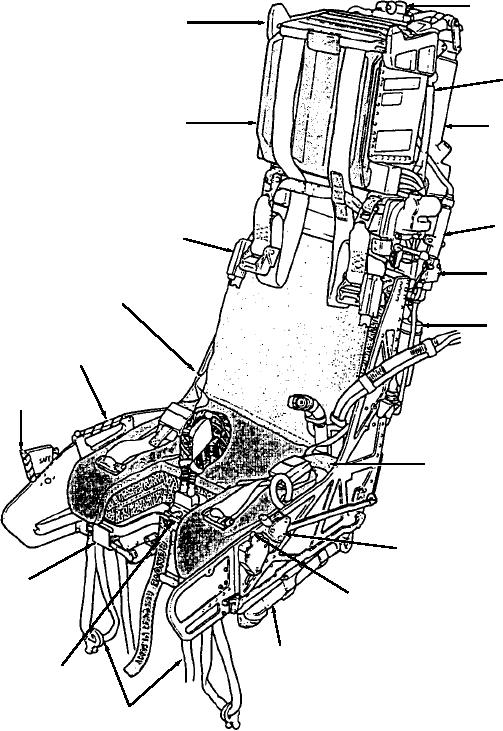
CATAPULT
MANIFOLD VALVE
CANOPY BREAKER (2)
LH PITOT
(STOWED)
HEADPAD
PARACHUTE
DEPLOYMENT
ROCKET
0.75-SECOND
DELAY CARTRIDGE
SEAWARS (2)
ACTUATED
INITIATOR
LH BALLISTIC
MANIFOLD
STICKER STRAP (2)
THERMAL
EMERGENCY RESTRAINT
BATTERIES
RELEASE HANDLE
SAFE/ARMED
HANDLE
HARNESS LAP STRAP(2)
SHOULDER HARNESS
CONTROL LEVER
LEG RESTRAINT
SEAT HEIGHT
LINE SNUBBER (2)
ACTUATOR SWITCH
LATERAL THRUST MOTOR
EJECTION CONTROL
HANDLE SAFETY PIN
LEG RESTRAINT LINES
Figure 2-2.--Forward ejection seat, LH view (SJU-17(V)2/A).
ignited. An underseat rocket motor is fired as the
cockpit canopy should the canopy jettison/fracturing
catapult reaches the end of its stroke and sustains the
system fail. After ejection, an on-board multi-mode
thrust of the catapult to carry the seat to a height
electronic sequencer automatically controls drogue
sufficient to deploy the parachute. The seat is stabilized
deployment, man/seat separation and parachute
and the forward speed retarded by a drogue and bridle
deployment. A barostatic release unit provides for
system, followed by automatic deployment of the
partial or total failure of the electronic sequencer and an
personnel parachute and separation of the occupant
emergency restraint release (manual override) system
from the seat. Timing of all events after rocket motor
provides a further backup in the event of failure of the
initiation is controlled by the electronic sequencer,
barostatic release.
which utilizes altitude and airspeed information to
The seat is ejected by the gas pressure developed
select the correct mode of operation.
within a telescopic catapult when the cartridges are
2-2

